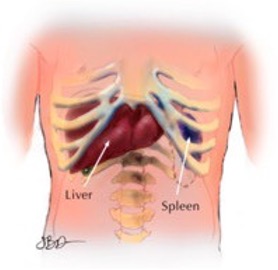Home » CLL / SLL Patient Education Toolkit » What is the Spleen?
What is the Spleen?
In science and medicine, information is constantly changing and may become out-of-date as new data emerge. All articles and interviews are informational only, should never be considered medical advice, and should never be acted on without review with your health care team.
 Takeaway Points:
Takeaway Points:
- Normally safely protected up under the left rib cage, the normal spleen weighs between 5 to 7 ounces and should not be palpable.
- In CLL and other diseases, the spleen can be enlarged to several times larger than normal and may extend well into the abdomen where it can felt during the palpation of the left side of the abdomen. This is called splenomegaly. If the spleen can be felt below the rib cage, it is considered enlarged and that CLL is becoming more serious.
- When enlarged, the spleen is at more risk to be injured and may even rupture in an accident. The enlargement can cause an unpleasant sense of fullness.
- The white pulp within the spleen acts as an immune organ, much like an enlarged lymph node. Lymphocytes, both normal and cancerous, can grow here.
- The red pulp within the spleen acts to rid the body of old red blood cells and platelets and recycles their contents, including the iron.
- The marginal zone is located between the red and white pulp. It acts as a blood filter trapping antigens from the circulation and passing them on to the white pulp where the lymphocyte can act on them.
- When enlarged, as in CLL, the spleen can overdo the clearing out of the blood cells leading to anemia and low platelets.
- On the other hand, when the body is stressed, the spleen can serve as a back up to the bone marrow by releasing blood cells into the circulation.
- The spleen helps the body defeat certain serious bacterial infections that can cause pneumonia and meningitis and other problems,
- One can live without a well-functioning spleen or even after its total removal.
Anatomy:
The spleen is found in the left upper quadrant of the abdomen and should not normally be felt during a physical exam. Even an enlarged spleen can be difficult to palpate especially in obese patients, because unlike the liver on the right side of the abdomen, its lower edge can be soft and hard to feel.
Function:
Although we can live without our spleen, it performs a few helpful functions
- It helps us fight certain infections, especially those caused by encapsulated bacteria.
- It can be a source of blood cells in an emergency and is a place where the lymphocytes can grow.
- It rids the body of old poorly functioning red cells and platelets.
Splenectomy (surgical removal of the spleen):
If the spleen is removed due to injury or other problems, its functions can be taken over by other organs such as the liver, the bone marrow and the lymph nodes.
If possible, it is best to be vaccinated four to six weeks before splenectomy to protect against the encapsulated bacteria. That included the shots against pneumonia, meningococcus and HIB (haemophilus influenza B) and also the flu shot if appropriate.
Splenectomy can often be done in a laparoscopic procedure that has a shorter recovery time. As it is not a common surgery such as a laparoscopic gallbladder removal, research supports searching out an experienced surgeon to lower the risk of complications.
The Spleen in CLL:
In CLL, the spleen may not be a clinically involved in any significant way and may be of no concern, or it can become enlarged, a condition called splenomegaly. That can lead to a full feeling in the abdomen and early satiety (sense of not being hungry).
Splenomegaly that causes complications is one indication for treating CLL. A massively enlarged spleen can lead to a significant drop in the red blood cell and platelet counts. It can also worsen autoimmune problems in CLL such as autoimmune hemolytic leukemia (AIHA) and immune thrombolytic cytopenia (ITP) where splenectomy is one treatment option.
Any therapy that successfully treats CLL will also treat the CLL in the spleen, usually shrinking the spleen (think of it as a huge CLL node) back to normal size with relief of symptoms and improved blood counts.
Summary:
While the spleen has long been associated in literature with the emotions, especially melancholy, it is in truth both a multitasking but fully expendable organ that can cause problems for those of us with CLL.

















